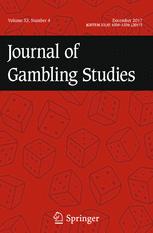 Título: The South Oaks Gambling Screen-revised Adolescent (SOGS-RA) Revisited: A Cut-point Analysis
Título: The South Oaks Gambling Screen-revised Adolescent (SOGS-RA) Revisited: A Cut-point Analysis
Autores: Brock Boudreau, Christiane Poulin
Data: 2007
Abstract
The lack of a criterion validity gold standard defining adolescent pathological gambling represents a major limitation of the adolescent gambling literature. The present study employed Receiver Operating Characteristic curve analysis (ROC) to examine the performance of the South Oaks Gambling Screen-Revised Adolescent (SOGS-RA) recommended cut-point of 4 against two-proxy gold standards: self-identified need for, or receipt of, help for gambling. Logistic regression analysis examined the correlates of self-identified need for help with gambling. The sample was comprised of 12990 adolescents from Atlantic Canada whose average age was 15 years and 50% of whom were male. The SOGS-RA performed as well or better with these proxy gold standards than with proxies used in previous studies. We concluded that the proxy gold standards based on self-identified need for or receipt of help represent a pragmatic solution to the lack of an adolescent-specific definition of problem or pathological gambling. Students in grade seven and SOGS-RA scores of 4 or greater were independent predictors of self-identifying a need for help.
References
-
Adlaf, E. M., Paglia-Boak, A., Beitchman, J. H., & Wolfe, D. (2006). The mental health and well-being of Ontario students 1991–2005 (CAMH Research Document Series No. 19). Toronto: Centre for Addiction and Mental Health.Google Scholar
-
Alberta Alcohol and Drug Abuse Commission (AADAC). (2005). Youth gambling in Alberta: the Alberta youth experience survey 2002. Edmonton, Alberta: Author.Google Scholar
-
American Psychiatric Association. (1994). Diagnostic and Statistical Manual of Mental Disorders (4th ed.). Washington, DC: Author.Google Scholar
-
Cox, B. J., Yu, N., Afifi, T. O., & Ladouceur, R. (2005). A national survey of gambling problems in Canada. Canadian Journal of Psychiatry, 50, 213–217.Google Scholar
-
DiClemente, C. C., & Prochaska, J. O. (1999). Toward a comprehensive, transtheoretical model of change: Stages of change and addictive behaviors. In W. R. Miller & N. Heather (Eds.), Treating addictive behaviors (2nd ed. pp. 3–24). New York: Plenum.Google Scholar
-
DiClemente, C. C., Story, H., & Murray, K. (2000). On a roll: the process of initiation and cessation of problem gambling among adolescents. Journal of Gambling Studies, 16, 289–313.PubMedCrossRefGoogle Scholar
-
Gupta, R., & Derevensky, J. L. (2000). Adolescents with gambling problems: from research to treatment. Journal of Gambling Studies, 16, 315–342.PubMedCrossRefGoogle Scholar
-
Hardoon, K., Derevensky, J. L., & Gupta, R. (2003). Empirical measures vs. perceived gambling severity among youth: why adolescent problem gamblers fail to seek treatment. Addictive Behaviors, 28, 933–946.Google Scholar
-
Jacobs, D. F. (1989). Illegal and undocumented: a review of teenage gamblers in America. In H. J. Shaffer, S. A. Stein, B. Gambino & T. N. Cummings (Eds.). Compulsive gambling: theory, research and practice. Lexington, MA: Lexington Books.Google Scholar
-
Jacobs, D. F. (2000). Juvenile gambling in North America: an analysis of long term trends and future prospects. Journal of Gambling Studies, 16, 119–152.PubMedCrossRefGoogle Scholar
-
Kezwer, G. (1995). Physicians say government-approved love affair with gambling sure bet to cause problems. Canadian Medical Association Journal, 154, 84–88.Google Scholar
-
Ladouceur, R., Blaszczynski, A., & Pelletier, A. (2004). Why adolescent problem gamblers do not seek treatment? Journal of Child and Adolescent Substance Abuse, 13(4), 1–12.CrossRefGoogle Scholar
-
Ladouceur, R., Ferland, F., Poulin, C., Vitaro, F., & Wiebe, J. (2005). Concordance between the SOGS-RA and the DSM-IV Criteria for pathological gambling among youth. Psychology of Addictive Behaviors, 19, 271–276.PubMedCrossRefGoogle Scholar
-
Lesieur, H. R., & Blume, S. (1987). The South Oaks Gambling Screen (SOGS): a new instrument for the identification of pathological gamblers. American Journal of Psychiatry, 144, 1184–1188.PubMedGoogle Scholar
-
Mackay, T-L., Patton, D., & Broszeit, B. (2005). Student gambling report, 2005. Retrieved September 19, 2006, from the Addictions Foundation of Manitoba website: http://www.afm.mb.ca/pdf/Student%20Gambling%20Report%202005.pdf.Google Scholar
-
Poulin, C. (2000). Problem gambling among adolescent students in the Atlantic provinces of Canada. Journal of Gambling Studies, 16, 53–77.PubMedCrossRefGoogle Scholar
-
Poulin, C. (2002). An assessment of the validity and reliability of the SOGS-RA. Journal of Gambling Studies, 18, 67–93.PubMedCrossRefGoogle Scholar
-
Poulin, C., Hand, D., Boudreau, B., & Santor, D. (2005). Gender differences in the association between substance use and elevated depressive symptoms in a general adolescent population. Addiction, 100, 525–535.CrossRefGoogle Scholar
-
Poulin, C., MacNeil, P., & Mitic, W. (1993). The validity of a province-wide student drug use survey: lessons in design. Canadian Journal of Public Health, 84, 259–264.Google Scholar
-
Prochaska, J. O., & DiClemente, C. C. (1982). Transtheoretical therapy: toward a more integrative model of change. Psychotherapy: Theory, Research and Practice, 19, 276–288.Google Scholar
-
Shaffer, H. J., Hall, M. N., & Vander Bilt, J. (1997). Estimating the prevalence of disordered gambling behaviour in the United States and Canada: a meta-analysis. Boston, MA: Harvard Medical School Division of Addictions.Google Scholar
-
StataCorp. (2005). Stata statistical software: Release 9.0. College Station, TX: Author.Google Scholar
-
Wiebe, J. M. D., Cox, B. J., & Mehmel, B. G. (2000). The South Oaks Gambling Screen Revised for Adolescents (SOGS-RA): further psychometric findings from a community sample. Journal of Gambling Studies, 16, 275–288.PubMedCrossRefGoogle Scholar
-
Winters, K. C., Stinchfield, R. D., & Fulkerson, J. (1993). Toward the development of an adolescent gambling problem severity scale. Journal of Gambling Studies, 9, 63–84.CrossRefGoogle Scholar
-
Winters, K. C., Stinchfield, R. D., & Kim, L. G. (1995). Monitoring adolescent gambling in Minnesota. Journal of Gambling Studies, 11, 165–183.CrossRefGoogle Scholar
















